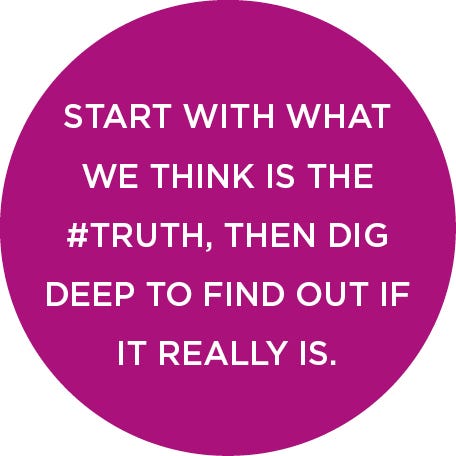Q: Where Do We Start? A: #truth
Breakthroughs in Pedagogy: The first few moments of a lesson are crucial: we call it the motivation.

Do we start with a joke? Do we unpack background knowledge? Do we start with the end and find out how we got there? Do we start with an open-ended question to show the diversity of thought in a classroom?
These are quality ways of kicking off a lesson, but I recently added something to my toolkit that came to me while watching a Disney movie with my daughters. It’s a model that’s been exciting and successful and it starts with the truth. I know, it does sound like an anticipation guide — assess what students know with a vote on certain statements and after your masterful teaching do the same to show deepened learning.
But here’s the twist: we start with #truth — the stuff we all think we know to be true, never question, and blindly accept. Then we spend the next few lessons trying to prove or disprove it.

Stop for a moment and think of your favorite Disney movie. Don’t pretend that you don’t have one! Mine is Pocahontas. I don’t know if it’s the music, the story, or the fact that we had a new kind of princess, who at the time broke the stereotype.
In Pocahontas, we learn some very basic facts about the first settlement at Jamestown, one of the anchor lessons in the fifth grade social studies curriculum and a topic we integrate into language arts.
We learn that:
• The English settled in Jamestown to look for gold and found none.
• Pocahontas helped the early settlers.
• Pocahontas saved John Smith’s life.
• Pocahontas fell in love with John Smith.
• John Smith sacrificed himself saving Chief Powhatan and was shot.
• The English and the Powhatan tribe worked out their differences when Smith left.
Before you stop reading and start thinking that I’m suggesting we all watch Disney movies to fulfill some language arts and social studies standards, stop and look at those statements! Only two of them are rock-solid true, one is debatable, and the others are just completely false. What I’m suggesting is that we start with what we think is the #truth, then dig deep to find out if it really is.

In my class we used three class periods to independently rotate through stations, watching videos, listening to songs, reading text books, articles, and letters, looking at paintings and photographs, and more. We dug through source after source trying to determine for ourselves if each statement was true or not. The language arts and social studies standards are easy to see here but by searching for and analyzing information themselves, my students developed their own opinions.

They became independent thinkers and problem solvers. I didn’t have to ask, “how do you know?” because they couldn’t wait to tell me. Looking at wedding paintings of Pocahontas and John Rolfe, reading letters from John Smith to Queen Anne, comparing the dates of Pocahontas’ birth to the arrival at Jamestown — all of these led to my favorite kind of classroom — one full of challenges and debate. By the end we, like historians, were split on whether Pocahontas actually saved John Smith. And we knew that Pocahontas wasn’t the princess’ real name, why the English went to Jamestown, why the colony succeeded, and why it almost failed.
The Pocahontas story not your thing? How about looking at The Little Mermaid against Hans Christian Anderson’s source material? Or digging deep into the merits of Columbus Day and whether it should be a national holiday? Or researching the Boston Tea Party or the attack on Pearl Harbor — was it completely unprovoked?
Do these topics challenge us? You bet! The goal is not just disproving but also proving how we know something is true. Either way the facts come out and students are doing what we love them to do — they are explaining themselves and developing their own opinions and understanding.

